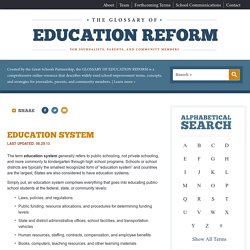

Links refs. Spain:Administration and Governance at Local and/or Institutional Level. The 1978 Spanish Constitution established a model of decentralised State by which educational powers are shared between all levels of government.

It is a symmetrical model, where the educational powers exercised are basically the same in each and every Autonomous Community. The competences in terms of education are shared between the State General Authority (Ministry of Education, Culture and Sport) and the Autonomous Communities (Regional Ministries or Departments of Education). In the Autonomous Cities of Ceuta and Melilla these competences are assumed by the Ministry of Education, Culture and Sport itself.
The role of local authorities is focused on educational management through the Education Departments or Municipal Education Institutes. The education authorities delegate the exercise of their functions to the municipalities in aspects having a direct impact on them. Spain:Primary Education. The 2006 Organic Act on Education (LOE) establishes Primary Education as an educational level structured in three cycles each of them made up by two years, studied from 6 to 12 years old.

The Spanish Ministry of Education, Culture and Sport (MECD) is responsible for setting the Core Curricula of this level, establishing the common objectives, contents and evaluation criteria for the whole State. The Education Authorities complete these aspects in their concerning management areas. Along with Lower Compulsory Secondary Education (ESO) it constitutes the basic, compulsory and cost-free education of the Spanish Education System.
Both levels are aimed at assuring the development of the basic competences: those competences to be acquired by pupils by the end of Compulsory Education in order to be able to fulfil themselves, exercise an active citizenship, satisfactorily take part in adult life and develop lifelong learning. Education System Definition. The term education system generally refers to public schooling, not private schooling, and more commonly to kindergarten through high school programs.

Schools or school districts are typically the smallest recognized form of “education system” and countries are the largest. States are also considered to have education systems. Simply put, an education system comprises everything that goes into educating public-school students at the federal, state, or community levels: Law. "Legal concept" redirects here.

Lady Justice, a symbol of justice. Governance - What is Governance? Governance and Good Governance: Varying Definitions Governance “The traditions and institutions by which authority in a country is exercised” – Kaufman et al The way “ … power is exercised through a country’s economic, political, and social institutions.” – the World Bank’s PRSP Handbook.

“The exercise of economic, political, and administrative authority to manage a country’s affairs at all levels. What is mind mapping? Useful mind mapping techniques explained. Mind mapping is a simple technique for drawing information in diagrams, instead of writing it in sentences.

The diagrams always take the same basic format of a tree, with a single starting point in the middle that branches out, and divides again and again. The tree is made up of words or short sentences connected by lines. The lines that connect the words are part of the meaning. What is Mind Mapping? (and How to Get Started Immediately) A mind map is a graphical way to represent ideas and concepts.

It is a visual thinking tool that helps structuring information, helping you to better analyze, comprehend, synthesize, recall and generate new ideas. Just as in every great idea, its power lies in its simplicity. What is a Concept Map? What is a Concept Map?

Alberto J. Cañas & Joseph D. Novak Institute for Human and Machine Cognitionwww.ihmc.us This document is part of the Cmappers.Learn section of www.cmappers.net. Visit the site to learn more about concept mapping. Introduction Concept maps are graphical tools for organizing and representing knowledge. Concept map. An Electricity Concept Map, an example of a concept map A concept map or conceptual diagram is a diagram that depicts suggested relationships between concepts.[1] It is a graphical tool that designers, engineers, technical writers, and others use to organize and structure knowledge.

A concept map typically represents ideas and information as boxes or circles, which it connects with labeled arrows in a downward-branching hierarchical structure. The relationship between concepts can be articulated in linking phrases such as causes, requires, or contributes to.[2] Overview[edit]
Una docena de factores que diferencian el sistema educativo español del finlandés. Nubes de palabras con Tagxedo, Wordle y Word It Out. There are no translations available. En el presente monográfico vamos a trabajar las nubes de palabras o "words clouds" en terminología anglosajona. Para este fin utilizaremos tres aplicaciones on-line gratuitas que nos brinda la web (Tagxedo, Wordle y Word It Out) y que nos permiten generar nubes de palabras personalizadas y configurables, en diversos formatos, entre los que se encuentra el formato web que nos permite obtener el código necesario para poder "embeber"-"incrustar" nuestra nube en cualquier blog, página web o repositorio de contenidos.
Para finalizar os propongo algunas ideas o sugerencias de utilización de las nubes de palabras en nuestro contexto educativo. Una nube de palabras (words cloud) es un conjunto de palabras que conforman una representación a través de una imagen que las engloba.